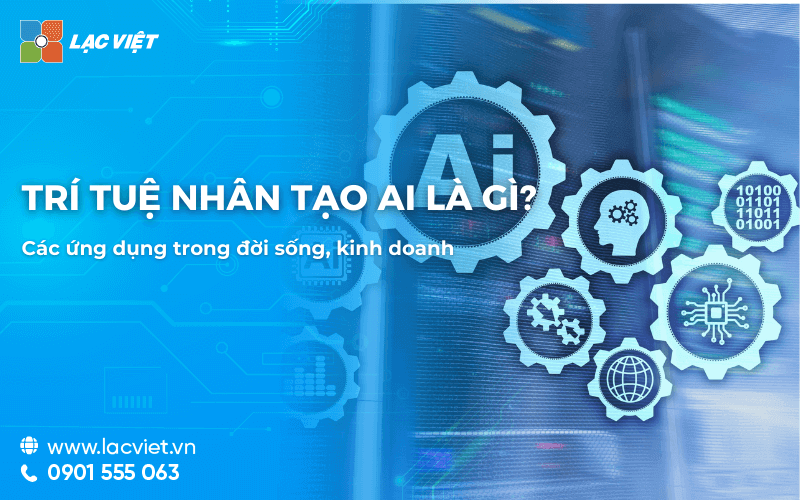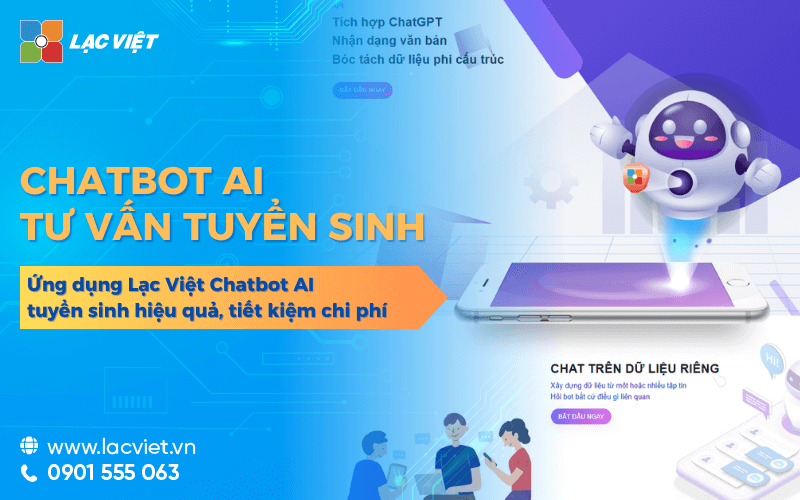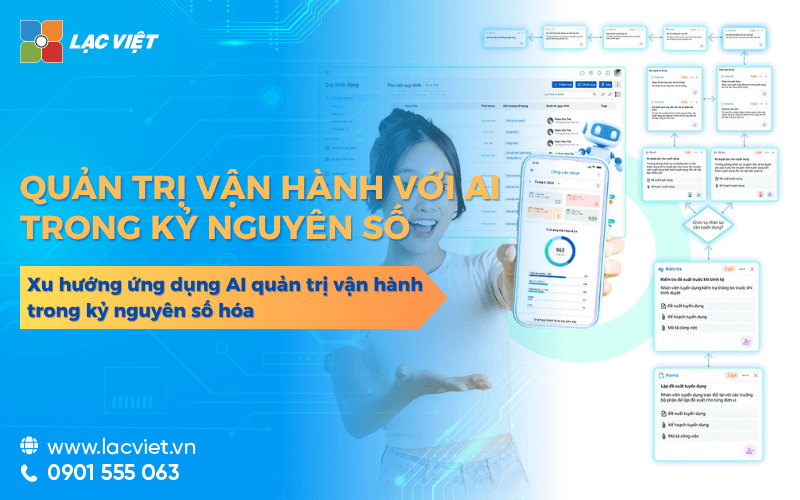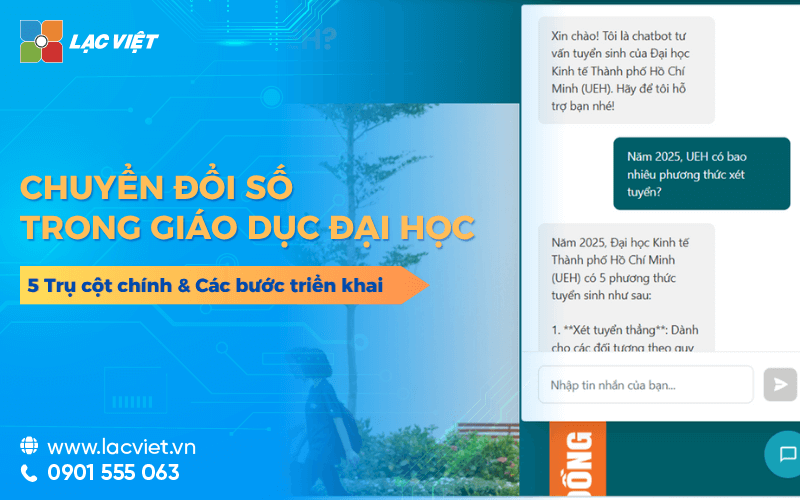Term artificial intelligence AI there is no longer a strange concept in modern life. From the automation of the production process complexity, optimize user experience, to support the areas of medical, education,... WHO are changing the way we live and work every day. So WHO really is? and applications in the life and business of AI, such as how?, tracked post Lac Viet Computing to get more information.
1. Concept artificial intelligence AI is what?
Artificial intelligence AI (Artificial Intelligence – AI) is a field of computer science focus on the creation of systems capable of performing tasks that typically need to the human intellect. These tasks include learning, reasoning, problem solving, understand natural language, voice recognition, and many other activities.
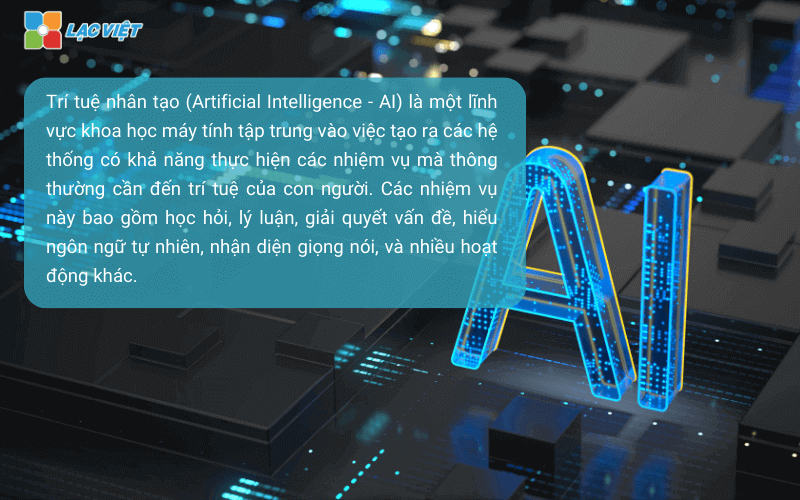
The technology artificial intelligence AI:
- Machine Learning (machine Learning) is a branch of artificial intelligence AI, the focus on the development of the algorithm, the model allows the computer to learn from data and improve the performance of them without the need of programming clear for each specific task. The typical application of the technology of machine learning including prediction and classification, image recognition, voice,...
- Deep Learning (deep Learning) leverage the network structure neurons, multiple floors to handle the data and create the model predicts strong, capable of handling large data sets. Typical applications include image recognition, language processing, natural, analysis, videos, ...
- Natural Language Processing (Processing natural language) is the field of research and application of the method allows the computer to understand, interpret, create human language. NLP combines linguistics and machine learning to develop the system have the ability to interact with humans using natural language. Typical applications: Chatbot virtual assistant, text analysis, machine translation,...
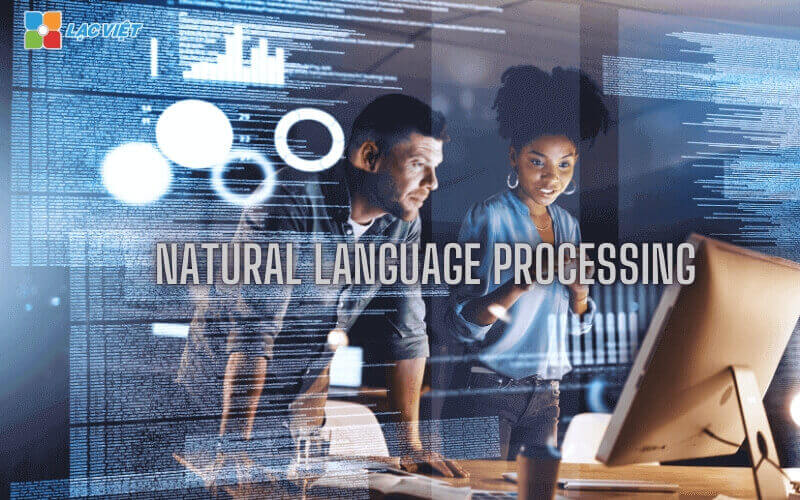
2. The stage of development of AI
Stage 1: primitive
In the first years, from the 1950s to the early 1970s, artificial intelligence, AI is primarily a field of theoretical research. Scientists have developed the theory and algorithms basic, but implementing them into practice is still very limited.
- 1943: Warren McCulloch and Walter Pitts published papers on neural network artificial.
- Year: 1950: Alan Turing introduced Turing test.
- 1956: the term “artificial intelligence” was introduced at the conference, Dartmouth by John McCarthy.
Stage 2: The birth of AI
This phase marks the formal launching of artificial intelligence AI with the research and development first.
- 1960s: The AI program first as ELIZA, a chatbot simulate conversation with users; SHRDLU a system interact with users in an environment of simple geometry is developed.
- 1970s: expert Systems (Expert Systems) began research and development. This is the computer program that can simulate human decision in the professional field such as medicine, finance.
Stage 3: AI development
From the 1980s to the early 2000s, artificial intelligence AI began to take the important step forward thanks to the development of computer technology and advances in machine learning algorithms.
- 1980s: expert Systems became popular, can be applied in many fields such as medicine (MYCIN), business (XCON). The company began to invest in research and development, WHO.
- 1990s: The advent of machine learning algorithms (machine learning) and neural network artificial (neural networks) has helped artificial intelligence AI progress. In 1997, Deep Blue of IBM, defeated chess grandmaster Garry Kasparov, marking an important milestone in the development of AI.
- 2000s: With the rise of big data (big data) and the improvements in computer hardware and algorithms, deep learning (deep learning) began to be widely used. WHO doesn't just stop at theory which began to have practical applications in many fields such as speech recognition, language processing, natural, computer vision.
Stage 4: The “boom” of AI
At present, artificial intelligence, AI has become an integral part in many areas of life and business. AI is widely used in many fields such as medical, educational, finance, transportation,business management. Technologies such as deep learning (deep learning), machine learning (machine learning), processing natural language (natural language processing) is leading in the development of application advanced AI.
- 2016: humanoid Robot first, Sophia, out of the public eye, was built by Hanson Robotics with the possibility of facial recognition, communication, and emotional expression.
- 2020: OpenAI released GPT-3, pattern language processing nature has the ability to create text-based AI.
- 5/2022: DeepMind introduced Gato AI system multi-methods can perform hundreds of different tasks such as play, create captions for pictures, use the robotic arm to stack blocks.
- 11/2022: OpenAI launches ChatGPT, a chatbot AI with the ability to interact conversation and feedback using natural language, to reach 100 million users in 2 months, the consumer application, the fastest growing history.
- 2023: The outbreak of ChatGPT fueled race to the research, development and application of AI global, with the participation of the major technology companies such as Microsoft, Google, Alibaba, Baidu.

3. The outstanding advantages of technology artificial intelligence AI
3.1. Automation and efficiency
Artificial intelligence AI allows the machine system, perform the automated tasks that previously required the intervention of humans. For example, in manufacturing, a robot can assemble products with speed and accuracy much higher than humans. The automation helps to reduce errors due to human-caused increase productivity .
3.2. Ability to analyze predict
One of the greatest power of artificial intelligence AI is the ability to analyze huge amount of data to find patterns and trends that human can ignore. For example, in finance, WHO can predict market fluctuations and suggest the strategy that the optimal investment.
Lac Viet Financial AI Agent to solve the “anxieties” of the business
For the accounting department:
- Reduce workload and handle end report states such as summarizing, tax settlement, budgeting.
- Automatically generate reports, cash flow, debt collection, financial statements, details in short time.
For leaders:
- Provide financial picture comprehensive real-time help in quick decision making
- Support troubleshooting instant on the financial indicators, providing forecast financial strategy without waiting from the related department.
- Warning of financial risks, suggesting solutions to optimize resources.
Financial AI Agent of Lac Viet is not only a tool of financial analysis that is also a smart assistant, help businesses understand management “health” finance in a comprehensive manner. With the possibility of automation, in-depth analysis, update real-time, this is the ideal solution to the Vietnam business process optimization, financial management, strengthen competitive advantage in the market.
SIGN UP CONSULTATION AND DEMO
3.3. Improve user experience
Artificial intelligence AI can provide the experience is personalized based on behavior, preferences of the user. For example, the platform ecommerce use AI to recommend products based on shopping history and searches of the users. The development services to music, watch movies such as Spotify and Netflix use AI to recommend content tailored to the individual preferences of each user.
3.4. Cost savings
The deployment of artificial intelligence AI into business processes can help reduce operating costs and increase efficiency. For example, in the field of customer care, using chatbot WHO instead support staff can directly reduce personnel costs in a significant way.
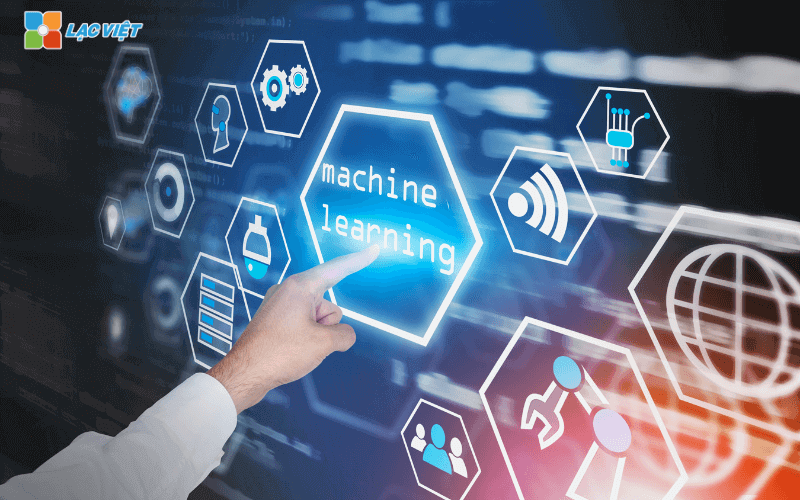
4. Application of artificial intelligence in the field of life
4.1. Business management
Trong lĩnh vực quản trị doanh nghiệp, AI đóng vai trò then chốt trong việc tối ưu hóa quy trình, nâng cao hiệu quả làm việc và cải thiện trải nghiệm nhân viên. Trợ lý ảo Lạc Việt chatbot AI assistant là một công cụ phát triển từ trí tuệ nhân tạo AI, tích hợp trong giải pháp quản trị doanh nghiệp LV-DX, giúp nâng cao hiệu suất công việc.

- Lạc Việt AI chatbot hỗ trợ doanh nghiệp trong công tác quản trị, vận hành từ kế toán, tài chính, quản lý khách hàng, cộng tác số đến quản trị nguồn nhân lực.
- Ứng dụng AI phân tích số liệu kinh doanh: Lạc Việt AI chatbot có khả năng phân tích khối lượng lớn dữ liệu kinh doanh để đưa ra những báo cáo chi tiết và dự đoán xu hướng.
- Trợ lý ảo giải đáp 24/7 thông tin nội bộ doanh nghiệp: Lạc Việt AI chatbot cung cấp hỗ trợ liên tục cho nhân viên, trả lời các câu hỏi về chính sách công ty, quy trình làm việc, các thông tin nội bộ khác. Điều này giúp giảm tải công việc cho bộ phận nhân sự đảm bảo mọi thông tin được truyền đạt một cách nhất quán và nhanh chóng.
- Trợ lý AI trong hoạt động quản lý kế toán: Lạc Việt AI chatbot hỗ trợ các công việc kế toán như xử lý hóa đơn, theo dõi chi tiêu và quản lý tài chính. AI giúp tự động hóa các quy trình này, giảm thiểu sai sót, tăng cường tính minh bạch trong quản lý tài chính.
- Ứng dụng AI trong tra cứu – ký duyệt trong các quy trình doanh nghiệp: Lạc Việt AI chatbot giúp tự động hóa quy trình tra cứu và ký duyệt tài liệu, giúp tiết kiệm thời gian và công sức của nhân viên.
Do you know businesses are spending a lot of money to pay for staff looking for information?
- Of 1.8 hours per day employees spend out to search and collect information, the equivalent of 9.3 hours per week
- Business loss 500 hours per year for employees to perform searches for information for work
- 63% leadership said the sharing of knowledge and information internal trouble, reduce the productivity of the business
Lac Viet Chatbot AI assistant – Freeing up personnel to focus on creative work
- Virtual assistant process – approved LV Chatbot AI for Workflow: Access quick information, content summary, revise errors on file the signed
- Virtual assistant accountant LV Chatbot AI assistant for Finance: remove input crafts, bring the data to the correct input, automatically prompt-term LIABILITIES – PAYMENTS, cash flow forecasting, warning of financial risks
- Virtual assistant customer care LV CareBot AI assistant: Integrated Chat on multi-platform, feedback and customer requests quickly, consulting, flexible, not being constrained by fixed script
- Virtual assistant hr LV Chatbot AI for HXM: save 70% time for HR and leadership, extract the entire database of candidates any file format, faq auto welfare policies, rules, regulations 24/7, statistical, personnel, resources, business in few seconds.
CONTACT INFORMATION:
- Lac Viet Computing Corporation
- Hotline: 0901 555 063 | (+84.28) 3842 3333
- Email: info@lacviet.vn – Website: https://lacviet.vn
- Headquarters: 23 Nguyen Thi Huynh, P. 8, Q. Phu Nhuan, Ho Chi Minh city
4.2. Health and education
Ứng dụng AI trong y tế giúp chẩn đoán và điều trị bệnh, phân tích hình ảnh y khoa như X-quang, MRI để phát hiện sớm các dấu hiệu bệnh tật. AI cũng hỗ trợ trong việc đề xuất phác đồ điều trị dựa trên dữ liệu bệnh nhân.
The App artificial intelligence can monitor the patient's health remotely, medication reminders, track health indicators and give early warning of health problems.
Trong lĩnh vực giáo dục, AI giúp tạo ra các chương trình học tập cá nhân hóa dựa trên khả năng và sở thích của từng học sinh, từ đó nâng cao hiệu quả học tập. Công nghệ AI trong giáo dục giúp giáo viên theo dõi tiến độ học tập của học sinh, đưa ra các bài kiểm tra phù hợp và hỗ trợ quản lý hành chính trường học.
4.3. Production
Artificial intelligence WHO has made important contributions in the manufacturing industry, from the optimization of the manufacturing process to improve product quality. Robots WHO can perform the task of producing a way of automatically and accurately, from the assembly, quality inspection to packing products. Predict when equipment needs maintenance based on operational data, from which minimize downtime and extend equipment life.
Application of artificial intelligence AI in life, has changed the way people interact, work in life. From the support business management to improve the areas in life. With the continuous development of technology, WHO promises to continue to bring breakthroughs and new benefits, help humanity forward into a future smarter.
CONTACT INFORMATION:
- Lac Viet Computing Corporation
- Hotline: 0901 555 063 | (+84.28) 3842 3333
- Email: info@lacviet.vn – Website: https://lacviet.vn
- Headquarters: 23 Nguyen Thi Huynh, P. 8, Q. Phu Nhuan, Ho Chi Minh city

